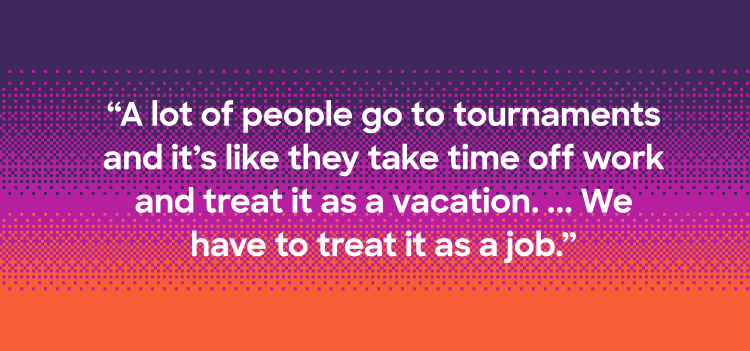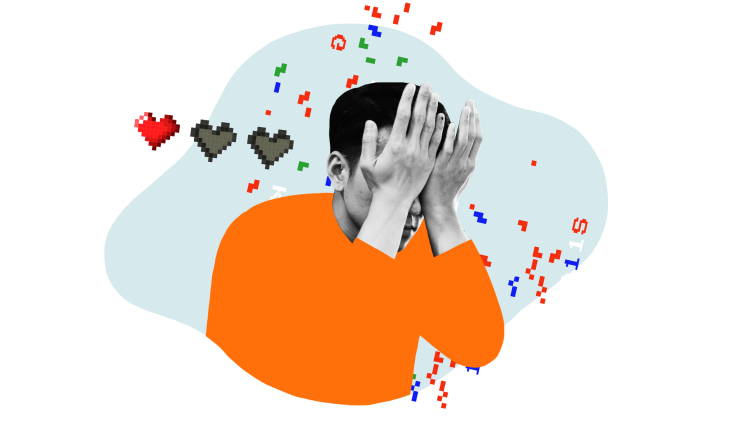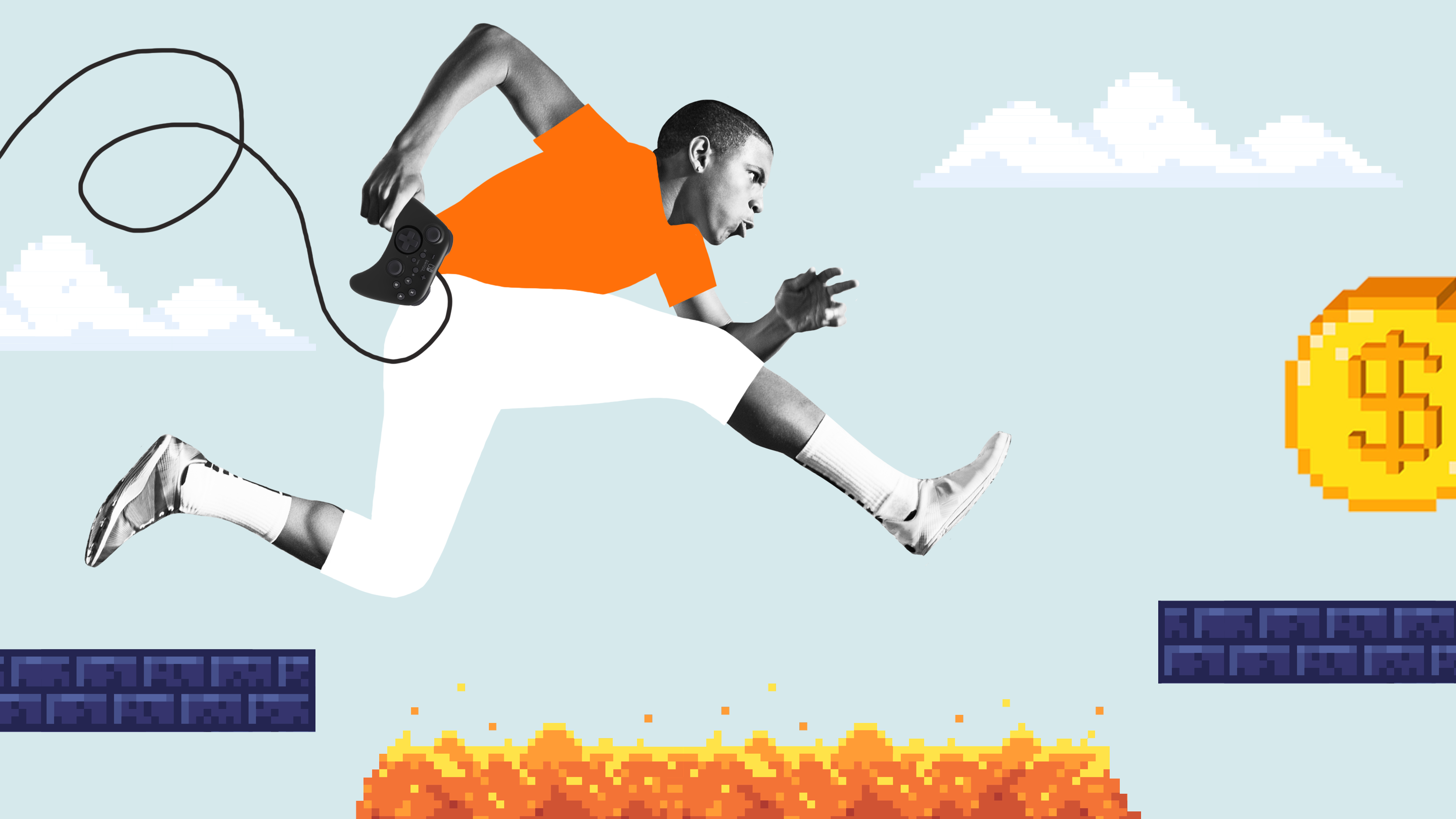It’s mid-July, and the temperature has hit triple digits. In the Wyndham New Yorker Hotel, the air conditioning fights a losing battle against the warmth of hundreds of humming video game consoles. But the youths crowded around these consoles hardly notice the stifling heat. They are laser-focused, transfixed by the gameplay unfolding before their eyes.
More than a thousand competitors have congregated in the ritzy Midtown hotel for Defend the North 2019, one of New York�’s premier esports events. With tens of thousands of dollars on the line, these competitors — mostly men — have come from far and wide to refine their skills, attract sponsors, and turn their passion for gaming into money. Of these players, roughly 20 make their living competing full-time.
Defend the North showcases fighting games such as Super Smash Bros., Street Fighter, Mortal Kombat, and Marvel vs. Capcom. Though they occupy a prominent role within the esports ecosystem, fighting games are less glamorous than larger esports, such as Fortnite, with its $30 million prize pools, and League of Legends, with its six-figure player salaries. But the fighting game world still contains ample opportunity for industrious players to make a living out of their craft.
Samuel “Dabuz” Buzby, a 2017 graduate of Stony Brook University, has been an elite Smash competitor for almost 10 of his 26 years. He recently secured the No. 7 spot on the worldwide Smash Ultimate rankings, and is the second seed at Defend the North.
Though Smash is an individual esport, most top competitors play under the auspices of larger teams or sponsors, who pay them and provide them with logistical support. Over the course of his career, Buzby has worn the jerseys of four different teams. He joined his current organization, Team Liquid, in March.
Founded in 2000, Team Liquid is one of the world’s most successful esports organizations, with championship titles in esports such as Dota 2, League of Legends, StarCraft II, and more. Valued at $200 million by Forbes last year, Liquid is able to offer higher salaries than many of its rivals.
“The reason I can look at apartments to move out now is because I’m on Liquid,” Buzby says. “So that is pretty life-changing.”

Monthly salaries for professional Smash players typically range from $1,000 to $5,000, with teams covering the costs of transit, housing and food when their members attend major tournaments. Most salaried players are legally considered independent contractors, paying the 15.3% self-employment tax for what is essentially freelance work. The majority of teams do not provide health insurance to their players, instead offering industry-specific benefits such as social media management, public relations support, and gifts of technology and apparel.
Read our comprehensive money guide for freelancers.
This lack of health insurance can be particularly scary for prolific competitors, who risk repetitive stress injuries to their hands and wrists. With players performing hundreds of actions per minute, gaming pushes the muscles and tendons of the human hand far beyond their natural capacity. A balanced regimen of hand stretches can help most players avoid lasting injury, but incorrect posture or unlucky accidents can cause serious issues for less vigilant competitors.
Fears of hand injury are on full display at Defend the North, where many players massage their forearms or wear wrist braces between sets. Some Smash players show up with box-style controllers, specially designed to help them compete without incurring serious damage.

The journeyman
Numerous Smash professionals have been forced to retire or take protracted breaks due to concerns over conditions like carpal tunnel syndrome and “gamer’s thumb,” a repetitive stress injury. In December, Smash pro James “Swedish Delight” Liu visibly grimaced with pain as he fought his way to a second-place finish (and $1,365 payout) at a Seattle competition. Liu was one of the lucky ones whose hand issues faded away without incident, but his foray into full-time competition between 2017 and 2018 taught the 25-year-old Rutgers graduate that esports was not his ideal career.
Liu’s first sponsorship opened his eyes to the sheer number of expenses accrued by traveling professionals. “A lot of people go to tournaments and it’s like they take time off work and treat it as a vacation,” Liu says. “But as players, we’re not able to. We have to treat it as a job. So outside-tournament expenses are really important too, like choosing where to eat or what transportation to use.”
Liu’s contract with European team OG was less lucrative than Buzby’s deal with Team Liquid, and he found himself cutting costs to stretch his salary. He moved back in with his parents to avoid paying rent.
In order to go pro, Liu gave up an administrative job at a Brooklyn hospital in 2017. “I wanted to see what it would be like to try to have a career in Smash after teams started getting in,” he says. “Esports as a whole was getting bigger, so I wanted to learn more about that.”
Since then, he estimates that his Smash income has totaled no more than $70,000, including the value of free flights and other benefits.
In July, Liu exited full-time Smash to enroll in medical school at Seton Hall University. Still, he values his experience as a professional player and remains confident that more sustainable pathways to esports careers will develop in time. “Overall, it’s getting better,” he says. “We’re just getting more worried because we’re using our heads and trying to think about it. It was only a few years ago that I was in college and feeling like there was no way anyone could make it full-time.”
The elite competitor
Buzby, who first joined a professional team in 2016, estimates that he has earned a total of $180,000 through competitive Smash. “It was a better job than what I was finding with my bachelor’s degree in economics,” he says.
A significant chunk of Buzby’s Smash income comes from livestreaming. “If you’re regularly streaming, with quality, quantity and everything, the income is consistent,” Buzby says. Indeed, many top esports players supplement their salaries by streaming on Twitch, America’s largest livestreaming platform. Spectating is free on the Amazon-owned website, but fans can pledge monthly $5 subscriptions to access exclusive perks such as custom Twitch chat emoticons and opportunities to interact with their idols.
In the streaming world, team affiliation gives a tremendous edge: Low-level streamers must dedicate 50% of each subscription to Twitch, while players on Twitch-sponsored teams are granted a 70% cut.
“If you look at someone’s jersey and they have Twitch on it, then they’re probably getting $3.50 ,” Liu says. Thanks in part to this advantage, a popular player can make many times his salary in Twitch subscriptions every month.
On top of this streaming income, top competitors often receive free flights from tournament organizers, who hope to entice lower-level players to travel to their events by offering them opportunities to hobnob with — and compete against — their favorite pros. Occasionally, organizers will go one step further, doling out appearance fees (“a couple hundred dollars,” Buzby discloses) for top players to attend their events. Professionals can also make decent money by offering fans private lessons or coaching for an hourly fee.
And of course, competitors can earn significant income by placing well at tournaments, though many teams take a cut from their players’ winnings. This cut is “extremely fair,” Buzby says. To date, Smash’s largest-ever payout is the $29,315.30 that Juan “Hungrybox” DeBiedma scored for winning Smash Summit 5 in November 2017. (The third-largest is the $20,000 first prize that Buzby won at Thunder Smash in May.)
Super Smash Bros. is the most popular fighting game in the world, but its payouts are small compared to the prizes awarded to champions in some larger esports. Invictus Gaming’s seven players split a prize of $2.4 million for winning the League of Legends World Championship last year, and the winning team at last year’s Dota 2 International took home a whopping $11 million. Both events were able to offer such enormous payouts thanks to large cash infusions from the developers of each game, Riot Games and Valve Corporation, respectively. Nintendo, the developer behind Smash, rarely provides this kind of monetary support to the competitive scene, though it occasionally publicizes events or supplies tournament organizers with consoles and other hardware. Nintendo did not respond to a request seeking comment for this article.
As a result of this payout disparity, most Smash players’ contracts require them to share a much smaller portion of their winnings with their organizations than their teammates in esports like League or Dota 2. But the same grassroots infrastructure that keeps prize pools relatively low has prevented the Smash scene from becoming overly reliant on developer funding, allowing Smash, which was released in 2001, to outlast many other esports that have folded after their corporate money-well runs dry.

The hometown hero
Major tournaments are must-attend events for any Smash player with top-level dreams, but these national events are few and far between, with fewer than 20 each year. Even Defend the North, New York’s biggest fighting game tournament, is at best a second- or third-tier event. With majors in short supply, players looking to increase their profits must also attend smaller local tournaments.
Robert Fraser, the top player in Kansas, spent much of 2015 and 2016 living almost entirely off winnings from local events while playing under the nom de guerre of “Bobby Frizz.” Before competing full-time, Fraser entered Smash tournaments on the side while working various restaurant jobs. At the time, says Fraser, he viewed his Smash success as a “safety net” that he could fall back on if his full-time job didn’t work out — not a means to pay all of his bills.
At age 19, Fraser decided to quit his job at Chipotle and attend every tournament he could, traveling to neighboring regions such as Nebraska and Iowa to increase his take. “I just hated how workers were treated at the wage jobs I was doing,” he says. “It was something I felt good about doing.”
At the time, esports was just beginning to blast off in the Midwest. “It was kind of impulsive at that point, but there were so many tournaments going on at the time, and it’s just kind of weird, the amount of money,” says Fraser, who would often pocket hundreds of dollars at local tournaments. “A lot of the time, it would be smaller donors, just a local business or something.” These small arcades or video game stores would offer large pot bonuses at these events, Fraser said.
Fraser’s local winnings were enough for him to make rent and pay for food and gas each month. But the uncertain future of smaller weeklies, which often run at a loss due to the rental or ownership costs of tournament venues, made him look elsewhere for additional sources of cash. “I was donating a lot of plasma, too, when I first started living off of Smash,” Fraser adds. “I was donating plasma like twice a week, all the time, for like a year.”
Tired of this lifestyle and discouraged by his shrinking local scene, Fraser, now 23, eventually gave up the full-time life to pursue his education.

Smaller tournaments often struggle to remain accessible to underprivileged or younger players who have trouble paying entry fees of $15 to $20 on a weekly basis. If events increase their entry fees, they risk alienating these members of the community. “I keep my prices as low as possible to make sure everyone from all walks of life can afford to attend,” says Carlos Luis Iñamagua, a New Jersey organizer. “The downside to this is that, unless I hit a certain number of entrants, I am almost always in the negative.”
These financial struggles are exacerbated by the fact that smaller local events have lost their luster to some top-level professionals. Buzby, for example, is beginning to consider the big picture. “The money at locals isn’t worth it at all, quite frankly,” he says. “I could stay at home and stream, build up more followers, get more subs, and build more income long-term than the short-term income gotten from winning a local, whereas streaming, at this point, is guaranteed income.”
As with many sports, competitive gaming is only a viable career option for players who are able to compete at the highest level. Many journeymen work part-time and rely on Twitch subscriptions to make ends meet, though bigger games like League of Legends and Overwatch provide some opportunities for developing talent in the form of B-leagues or farm systems.
Sponsorships have the potential to change players’ lives, as they did for Buzby. But less experienced professionals can fall prey to contracts that give organizations inordinate leverage over their players. Even after scoring partnerships with established teams, both Buzby and Liu are cagey about the specifics of their contracts, afraid that revealing specific numbers might displease organizational higher-ups and hurt their chances at future opportunities.
But five months into his Team Liquid contract, Buzby is confident that the skills he’s developed as a top-level competitor will prove invaluable, whether he ends up in esports or elsewhere.
“I have good marketing experience, branding, social media, public speaking skills — and those are all really good skills to have,” he says. “Every business needs people who know how to brand, who know how to speak, and who know how to be charismatic and get their word out in a way that appeals to whatever their demographic is. So it doesn’t matter what I would do in that regard, because you can apply those skills to anything.”
Want more features in your inbox? Sign up for the Easy Money newsletter.
Images: Nastia Kobzarenko
